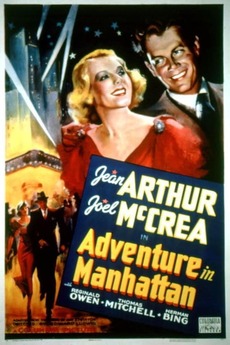
Director:
Edward Ludwig
Year: 1936
Rating: 6.0
Considering the two leads in this film it is rather surprising at how little known it is. It is admittedly a slight mystery comedy romance that only comes in at 72 minutes signifying its lack of importance to Columbia, but it is a fun little romp. Both actors had been around for a while in a number of films that made no splash and both had gone through a few ups and downs. But if you watch this - admittedly knowing what was ahead of them - you have to wonder why they were not already big stars. Their easy relaxed chemistry and charm is visible. It is all that keeps this film from floating away.
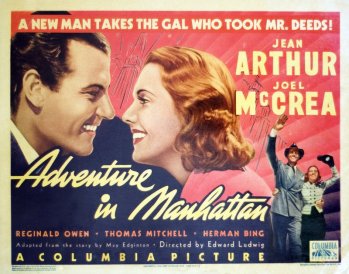
Joel McCrea had an interesting career. For the first fifteen years he specialized in modern social manner comedies or dramas in which he was usually this amiable likable sophisticated straight from the heartland kind of fellow - a little like Jimmy Stewart in that regard - but a very different acting style. He did a few action films in there as well - The Most Dangerous Game and a Western or two - but the film that put him on the map was Sullivan's Travels and a couple other Preston Sturgis films - The Palm Beach Story and The Great Moment (a terrible dud of a movie). A few other classics - the terrific Hitchcock Foreign Correspondent and The More the Merrier in which he co-stars with Jean Arthur. Then with his face having lost some of that innocent glow by 1947 he basically made only Westerns for the rest of his career. And they are terrific and he seems made for them. McCrea, Stewart and Randolph Scott all had career renaissances with the Western in the 1950s.

His co-star here is Jean Arthur. I adore her. I think nearly everyone does. Watching her is like having your cat curl up on your lap. That high pitched voice that cracks like a sputtering fire cracker when she gets nervous or emotional is incredibly appealing. An interesting face that is flawed yet enchanting - far from a classic Hollywood beauty. Harry Cohn the head of Columbia said of her face, it is half angel and half horse. I would disagree with that but it is an unusual face. On the screen she just radiates at times - always a little shy, a little withdrawn, cynical at times but full of fire when she needs to be. But by 1936 she had been making films for 13 years and no one was predicting fame for her - well except for two men. Fans today often think her career began with Mr. Deeds Goes to Town, the film that made her a star - but there was a lot of failure before then.

In her very first film - which they gave her the lead - she was fired within a few days. She had no clue how to act. She had been discovered with a photo shoot she did and invited to come to Hollywood. After that starting in 1923 she was in smaller roles, shorts until she started making of all things B Westerns. A lot of them in which she was the female lead but probably secondary to the horse. Through the silent period this is what she mainly did - then came the talkies - and she was in a few films I have seen - two Philo Vance films and two Fu Manchu films - and she is terrible. I didn't even recognize her in a couple of those. Her speech is stilted and flat - that famous voice of hers just doesn't come across. Her career was in a standstill. No one knew what to do with her. So she left Hollywood and went back to New York for two years performing in plays - that were not all that successful either.
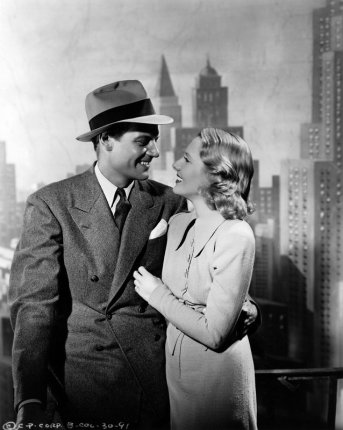
She came back two years later in 1933 and signed up with Columbia. At the time Columbia was considered a Poverty Row studio churning out low budget films and always in financial distress. That was to change the next year thanks to one man - Frank Capra. It Happened One Night with Gable and Colbert (who were both borrowed from other studios) was a huge hit - enormous and the money that flowed in allowed Columbia to start making A films. Arthur was making a number of films for Columbia, none that you have likely heard of - and then in 1935 John Ford who had directed Arthur years before cast her in The Whole Town's Talking with Edgar G Robinson. It wasn't huge but Ford liked her performance enough to show his film to Frank Capra and told him I think she has something special - we just have to bring it out. Capra agreed and began working with Arthur for months - bringing out her vulnerability, her hesitancy, her voice, how to photograph her and cast her in Mr. Deeds.
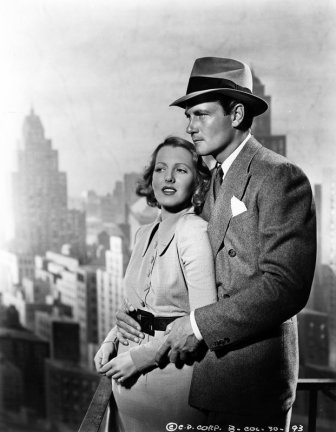
It made her America's sweetheart and she followed this up over the next few years with History is Made at Night, Easy Living (a film I love), Only Angels Have Wings, Mr. Smith Goes to Washington, The Devil and Miss Jones, You Can't Take It With You and The More the Merrier. And then she slowed down dramatically and only made a few more films - A Foreign Affair made four years after her previous film and Shane in 1953, five years since A Foreign Affair. And that was basically it. Arthur was famous for hating the Hollywood life, prizing her privacy, not being part of the party crowd. She once said that on the set I feel confident and can interact with everyone - but if I see these same people an hour later off the set I am tongue tied.
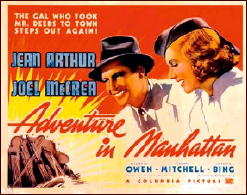
This film was made in the same year as Mr Deeds and released months after - but I have to wonder if it was planned before that film. It is such a small film and every other film she made in the 1930s after Mr Deeds was a big deal. It is a charming fluffy film though and Jean Arthur is very much the Jean Arthur we all love. But a pretty silly plot. McCrea is a crime reporter who is cocky and confident and doesn't hide it. When a famous diamond is stolen he declares that Berlea, a famous thief is behind it. Problem is Berlea died four years ago and so everyone scoffs. He also predicts that another theft will take place. In the meantime he is the target of a big practical joke by friends who use Arthur as the damsel in distress. Let's say lighthearted romance blooms. In the film as the traditional 1930's yelling hair pulling newspaper editor is Thomas Mitchell, one of the very great character actors for the next 20 years but this was only his second film.

Year: 1936
Rating: 6.0
Considering the two leads in this film it is rather surprising at how little known it is. It is admittedly a slight mystery comedy romance that only comes in at 72 minutes signifying its lack of importance to Columbia, but it is a fun little romp. Both actors had been around for a while in a number of films that made no splash and both had gone through a few ups and downs. But if you watch this - admittedly knowing what was ahead of them - you have to wonder why they were not already big stars. Their easy relaxed chemistry and charm is visible. It is all that keeps this film from floating away.

Joel McCrea had an interesting career. For the first fifteen years he specialized in modern social manner comedies or dramas in which he was usually this amiable likable sophisticated straight from the heartland kind of fellow - a little like Jimmy Stewart in that regard - but a very different acting style. He did a few action films in there as well - The Most Dangerous Game and a Western or two - but the film that put him on the map was Sullivan's Travels and a couple other Preston Sturgis films - The Palm Beach Story and The Great Moment (a terrible dud of a movie). A few other classics - the terrific Hitchcock Foreign Correspondent and The More the Merrier in which he co-stars with Jean Arthur. Then with his face having lost some of that innocent glow by 1947 he basically made only Westerns for the rest of his career. And they are terrific and he seems made for them. McCrea, Stewart and Randolph Scott all had career renaissances with the Western in the 1950s.

His co-star here is Jean Arthur. I adore her. I think nearly everyone does. Watching her is like having your cat curl up on your lap. That high pitched voice that cracks like a sputtering fire cracker when she gets nervous or emotional is incredibly appealing. An interesting face that is flawed yet enchanting - far from a classic Hollywood beauty. Harry Cohn the head of Columbia said of her face, it is half angel and half horse. I would disagree with that but it is an unusual face. On the screen she just radiates at times - always a little shy, a little withdrawn, cynical at times but full of fire when she needs to be. But by 1936 she had been making films for 13 years and no one was predicting fame for her - well except for two men. Fans today often think her career began with Mr. Deeds Goes to Town, the film that made her a star - but there was a lot of failure before then.

In her very first film - which they gave her the lead - she was fired within a few days. She had no clue how to act. She had been discovered with a photo shoot she did and invited to come to Hollywood. After that starting in 1923 she was in smaller roles, shorts until she started making of all things B Westerns. A lot of them in which she was the female lead but probably secondary to the horse. Through the silent period this is what she mainly did - then came the talkies - and she was in a few films I have seen - two Philo Vance films and two Fu Manchu films - and she is terrible. I didn't even recognize her in a couple of those. Her speech is stilted and flat - that famous voice of hers just doesn't come across. Her career was in a standstill. No one knew what to do with her. So she left Hollywood and went back to New York for two years performing in plays - that were not all that successful either.

She came back two years later in 1933 and signed up with Columbia. At the time Columbia was considered a Poverty Row studio churning out low budget films and always in financial distress. That was to change the next year thanks to one man - Frank Capra. It Happened One Night with Gable and Colbert (who were both borrowed from other studios) was a huge hit - enormous and the money that flowed in allowed Columbia to start making A films. Arthur was making a number of films for Columbia, none that you have likely heard of - and then in 1935 John Ford who had directed Arthur years before cast her in The Whole Town's Talking with Edgar G Robinson. It wasn't huge but Ford liked her performance enough to show his film to Frank Capra and told him I think she has something special - we just have to bring it out. Capra agreed and began working with Arthur for months - bringing out her vulnerability, her hesitancy, her voice, how to photograph her and cast her in Mr. Deeds.

It made her America's sweetheart and she followed this up over the next few years with History is Made at Night, Easy Living (a film I love), Only Angels Have Wings, Mr. Smith Goes to Washington, The Devil and Miss Jones, You Can't Take It With You and The More the Merrier. And then she slowed down dramatically and only made a few more films - A Foreign Affair made four years after her previous film and Shane in 1953, five years since A Foreign Affair. And that was basically it. Arthur was famous for hating the Hollywood life, prizing her privacy, not being part of the party crowd. She once said that on the set I feel confident and can interact with everyone - but if I see these same people an hour later off the set I am tongue tied.

This film was made in the same year as Mr Deeds and released months after - but I have to wonder if it was planned before that film. It is such a small film and every other film she made in the 1930s after Mr Deeds was a big deal. It is a charming fluffy film though and Jean Arthur is very much the Jean Arthur we all love. But a pretty silly plot. McCrea is a crime reporter who is cocky and confident and doesn't hide it. When a famous diamond is stolen he declares that Berlea, a famous thief is behind it. Problem is Berlea died four years ago and so everyone scoffs. He also predicts that another theft will take place. In the meantime he is the target of a big practical joke by friends who use Arthur as the damsel in distress. Let's say lighthearted romance blooms. In the film as the traditional 1930's yelling hair pulling newspaper editor is Thomas Mitchell, one of the very great character actors for the next 20 years but this was only his second film.
